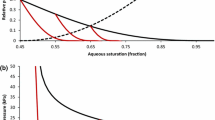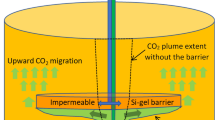Abstract
Carbon storage in saline formations is considered as a promising option to ensure the necessary decrease of CO2 anthropogenic emissions. Its industrial development in those formations is above all conditioned by its safety demonstration. Assessing the evolution of trapped and mobile CO2 across time is essential in the perspective of reducing leakage risks. In this work, we focus on residual trapping phenomenon occurring during the wetting of the injected CO2 plume. History dependent effects are of first importance when dealing with capillary trapping. We then apply the classical fractional flow theory (Buckley–Leverett type model) and include trapping and hysteresis models; we derive an analytical solution for the temporal evolution of saturation profile and of CO2 trapped quantity when injecting water after the gas injection (“artificial imbibition”). The comparison to numerical simulations for different configurations shows satisfactory match and justifies, in the case of industrial CO2 storage, the assumptions of incompressible flow with no consideration of capillary pressure. The obtained analytical solution allows the quick assessment of both the quantity and the location of mobile gas left during imbibition.
Similar content being viewed by others
Abbreviations
- q :
-
Volumetric flow rate, m3 s−1
- A :
-
Area, m2
- S :
-
Saturation
- f :
-
Volumetric fractional flow
- h :
-
Aquifer height, m
- T :
-
Injection time, s
- V :
-
Volume, m3
- fr :
-
Mass fraction
- k :
-
Permeability
- Q :
-
Injection volumetric flow, m3 s−1
- μ :
-
Viscosity, Pa s
- λ :
-
Mobility
- \({\varphi}\) :
-
Porosity
- r :
-
Radius, m
- \({\xi}\) :
-
Dimensionless radius
- ζ :
-
Similarity variable
- t :
-
Time, s
- τ :
-
Dimensionless time
- P :
-
Pressure, Pa
- ρ :
-
Density, kg m−3
- g:
-
Gas phase
- l:
-
Liquid phase
- Δ:
-
Flow reversal
- r:
-
Residual
- max:
-
Maximum
- rel:
-
Relative
- +:
-
Upstream
- −:
-
Downstream
- shocki:
-
Shock no.i
- *:
-
Chosen (given)
- collision:
-
Collision
- freeg:
-
Mobile gas
- c:
-
Capillary
References
Bachu S.: Sequestration of CO2 in geological media in response to climate change: road map for site selection using the transform of the geological space into CO2 phase space. Energy Convers. Manag. 43, 87–102 (2002)
Bachu S., Gunther W.D., Perkins E.H.: Aquifer disposal of CO2: hydrodynamic and mineral trapping. Energy Convers. Manag. 35(4), 269–279 (1994)
Bear J.: Dynamics of Fluids in Porous Media. Elsevier, New York (1972)
Brooks R.H., Corey A.T.: Hydraulic properties of porous media. J. Irrig. Drain. Div. Am. Soc. Civil Eng. 92, 61–88 (1966)
Buckley S.E., Leverett M.C.: Mechanism of fluid displacements in sands. Trans. AIME 146, 107–116 (1942)
Carlson, F.M.: Simulation of relative permeability hysteresis to the nonwetting phase. In: SPE 10157, Proceedings of the SPE Annual Technical Conference and Exhibition, San Antonio, TX, USA, October 5–7 (1981)
de Gennes P.G., Brochard-Wyart F., Quere D.: Capillarity and Wetting Phenomena Drops, Bubbles, Pearls, Waves. Springer-Verlag, New York (2003)
Dentz M., Tartakovsky D.M.: Abrupt-interface solution for carbon dioxide injection into porous media. Transp. Porous Med. 79, 15–27 (2009)
Doughty C.: Modeling geologic storage of carbon dioxide: comparison of non-hysteretic and hysteretic characteristic curves. Energy Convers. Manag. 48, 1768–1781 (2007)
Doughty, C.: User’s guide for hysteretic capillary pressure and relative permeability functions in iTOUGH2. In: Report LBNL-2483E. Lawrence Berkeley National Laboratory, Berkeley, CA, USA (2009)
EC (European Commission): Directive 2009/31/EC of the European Parliament and of the Council of 23 April 2009 on the geological storage of carbon dioxide and amending Council Directive 85/337/EEC, European Parliament and Council Directives 2000/60/EC, 2001/80/EC, 2004/35/EC, 2006/12,EC, 2008/1/EC and Regulation (EC) No 1013/2006 (2009).
Ennis-King J., Paterson L.: Role of convective mixing in the long-term storage of carbon dioxide in deep saline formations. SPE J. 10(3), 349–356 (2005)
Esposito, A., Benson, S.: Remediation of possible leakage from geologic CO2 storage reservoirs into groundwater aquifers. In: Proceedings of the Greenhouse Gas Control Technologies—10th International Conference, Amsterdam, The Netherlands. Sept. 19–23 (2010)
Furati K. M.: Effects of relative permeability history dependence on two-phase flow in porous media. Transp. Porous Med. 28, 181–203 (1997)
Gasda S.E., Nordbotten J.M., Celia M.A.: Vertical equilibrium with sub-scale analytical methods for geological CO2 sequestration. Comput. Geosci. 13, 469–481 (2009)
Gunter W.D., Wiwchar B., Perkins E.H.: Aquifer disposal of CO2-rich greenhouse gases: extension of the time scale of experiment for CO2-sequestering reactions by geochemical modeling. Miner. Pet. 59(1–2), 121–140 (1997)
Hesse, M.A., Tchelepi, H.A., Orr, F.M. Jr: Scaling analysis of the migration of CO2 in saline aquifers. In: SPE Annual Technical Conference and Exhibition (SPE 102796), San Antonio, TX (2006)
Hesse M.A., Tchelepi H.A., Cantwell B.J., Orr F.M. Jr: Gravity currents in horizontal porous layers: transition from early to late self-similarity. J. Fluid Mech. 577, 363–383 (2007)
IEA Greenhouse Gas R&D Programme (IEA GHG): Role of Risk Assessment in Regulatory Framework for Geological Storage of CO2: Feedback from Regulators and Implementers. Report 2007/2, 88 p. (2007)
Intergovernmental Panel on Climate Change (IPCC): Special Report on Carbon Dioxide Capture and Storage [Metz, B., Davidson, O., de Connick, H., Loos, M., Meyer, L. (eds.)] Cambridge University Press, New York (2005)
Juanes, R., MacMinn, C.W.: Upscaling of capillary trapping under gravity override: application to CO2 sequestration in aquifers. In: SPE/DOE Symposium on Improved Oil Recovery (SPE 113496), Tulsa, OK, USA (2008)
Juanes, R., Patzek, T.W.: Multiscale finite element methods for miscible and immiscible flow in porous media. In: CD Proceedings of the International Groundwater Symposium of the IAHR, Berkeley, California, March 2002 (2002)
Juanes R., Spiteri E.J., Orr F.M. Jr, Blunt M.J.: Impact of relative permeability hysteresis on geological CO2 storage. Water Resour. Res. 42, W12418 (2006). doi:10.1029/2005WR004806
Juanes R., MacMinn C.W., Szulczewski M.L.: The footprint of the CO2 plume during carbon dioxide storage in saline aquifers: storage efficiency for capillary trapping at the basin scale. Transp. Porous Med. 82, 19 30 (2010)
Kochina I.N., Mikhailov N.N., Filinov M.V.: Groundwater mound damping. Int. J. Eng. Sci. 21, 413–421 (1983)
Land C.S.: Calculation of imbibition relative permeability for two- and three-phase flow from rock properties. SPE J. 8, 149–156 (1968)
Lax P.D.: The formation and decay of shock waves. Am. Math. Monthly 79(3), 227–241 (1972)
Lenhard R.J., Parker J.C.: A model for hysteretic constitutive relations governing multiphase flow—2. Permeability–saturation relations. Water Resour. Res. 23(12), 2197–2205 (1987)
Lenormand R., Zarcone C., Sarr A.: Mechanisms of the displacement of one fluid by another in a network of capillary ducts. J. Fluid Mech. 135, 123–132 (1983)
MacMinn C.W., Szulczewski M.L., Juanes R.: CO2 migration in saline aquifers Part 1. Capillary trapping under slope and groundwater flow. J. Fluid Mech. 662, 329–351 (2010)
Manceau, J.C., Réveillère, A., Rohmer, J.: Forcing gaseous CO2 trapping as a corrective technique in the case of abnormal behavior of a deep saline aquifer storage. In: Proceedings of the Greenhouse Gas Control Technologies—10th International Conference, Amsterdam, The Netherlands. Sept. 19–23 (2010)
McWorther D.B., Sunada D.K.: Exact integral solutions for two-phase flow. Water Resour. Res. 26(3), 399–413 (1990)
Medeiros H.B., Marchesin D., Paes Leme P.J.: Hysteresis in two-phase flow: a simple mathematical model. Comp. Appl. Math. 17(1), 81–99 (1998)
Müller N.: Supercritical CO2-brine relative permeability experiments in reservoir rocks—literature review and recommendations. Transp. Porous Med. 87, 367–383 (2011)
Nghiem L., Yang C., Shrivastava V., Kohse B., Hassam M., Card C.: Risk mitigation trough the optimization of residual gas and solubility trapping for CO2 Storage in saline aquifers. Energy Procedia 1, 3015–3022 (2009)
Noh M., Lake L., Bryant S., Araque-Martinez A.: Implications of coupling fractional flow and geochemistry for CO2 injection in aquifers. SPE REE J. 10(4), 406–414 (2007)
Nordbotten J.M., Celia M.A.: Similarity solutions for fluid injection into confined aquifers. J. Fluid Mech. 561, 307–327 (2006)
Nordbotten J.M., Celia M.A., Bachu S.: Injection and storage of CO2 in deep saline aquifers: analytical solution for CO2 plume evolution during injection. Transp. Porous Med. 58(3), 339–360 (2005)
Parker J.C., Lenhard R.J.: A model for hysteretic constitutive relations governing multiphase flow—1. Saturation–pressure relations. Water Resour. Res. 23(12), 2187–2196 (1987)
Pinder G.F., Celia M.A.: Subsurface Hydrology. Wiley, Hoboken (2006)
Pruess K.: ECO2N: A TOUGH2 Fluid Property Module for Mixtures of Water, NaCl, and CO2. Report LBNL-57952. Lawrence Berkeley National Laboratory, Berkeley (2005)
Pruess K., Spycher N.: ECO2N—a fluid property module for the TOUGH2 code for studies of CO2 storage in saline aquifers. Energy Convers. Manag. 48, 1761–1767 (2007)
Pruess K., Oldenburg C.M., Moridis G.: TOUGH2 User’s Guide, Version 2.0. Report LBNL-43134. Lawrence Berkeley National Laboratory, Berkeley (1999)
Qi R., LaForce T.C., Blunt M.J.: Design of carbon dioxide storage in aquifers. Int. J. Greenh. Gas Control 3, 195–205 (2009)
Smoller J.: Shock Waves and Reaction–Diffusion Equations. Springer-Verlag, New York (1994)
Spiteri E.J., Juanes R., Blunt M.J., Orr F.M. Jr: A new model of trapping and relative permeability hysteresis for all wettability characteristics. SPE J. 13(3), 277–288 (2008)
Suicmez V.S., Piri M., Blunt M.J.: Effects of wettability and pore-level displacement on hydrocarbon trapping. Adv. Water Resour. 31, 503–512 (2008)
Valvatne, P.H.: Predictive pore-scale modeling of multiphase flow. A dissertation submitted to the Department of Earth Science and Engineering of Imperial College London in partial fulfillment of the requirements for the degree of Doctor of Philosophy (2004)
van Genuchten M.T.: A closed-form equation for predicting the hydraulic conductivity of unsaturated soils. Soil Sci. Soc. Am. J. 44, 892–898 (1980)
van Kats F.M., van Duijn C.J.: A mathematical model for hysteretic two-phase flow in porous media. Transp. Porous Med. 43, 239–263 (2001)
Vilarrasa V., Bolster D., Dentz M., Olivella S., Carrera J.: Effects of CO2 compressibility on CO2 storage in deep saline aquifers. Transp. Porous Med. 85, 619–639 (2010)
Welge H.J.: A simplified method for computing oil recovery by gas or water drive. Petrol. Trans. AIME 195, 91–98 (1952)
Yortsos Y.C.: A theoretical analysis of vertical flow equilibrium. Transp. Porous Med. 18, 107–129 (1995)
Zeidouni M., Pooladi-Darvish M., Keith D.: Analytical solution to evaluate salt precipitation during CO2 injection in saline aquifers. Int. J. Greenh. Gas Control 3, 600–611 (2009)
Zhou Q., Birkholzer J.T., Tsang C.F., Rutqvist J.: A method for quick assessment of CO2 storage capacity in closed and semi-closed saline formations. Int. J. Greenh. Gas Control 2(4), 626–639 (2008)
Author information
Authors and Affiliations
Corresponding author
Rights and permissions
About this article
Cite this article
Manceau, JC., Rohmer, J. Analytical Solution Incorporating History-Dependent Processes for Quick Assessment of Capillary Trapping During CO2 Geological Storage. Transp Porous Med 90, 721–740 (2011). https://doi.org/10.1007/s11242-011-9812-z
Received:
Accepted:
Published:
Issue Date:
DOI: https://doi.org/10.1007/s11242-011-9812-z




